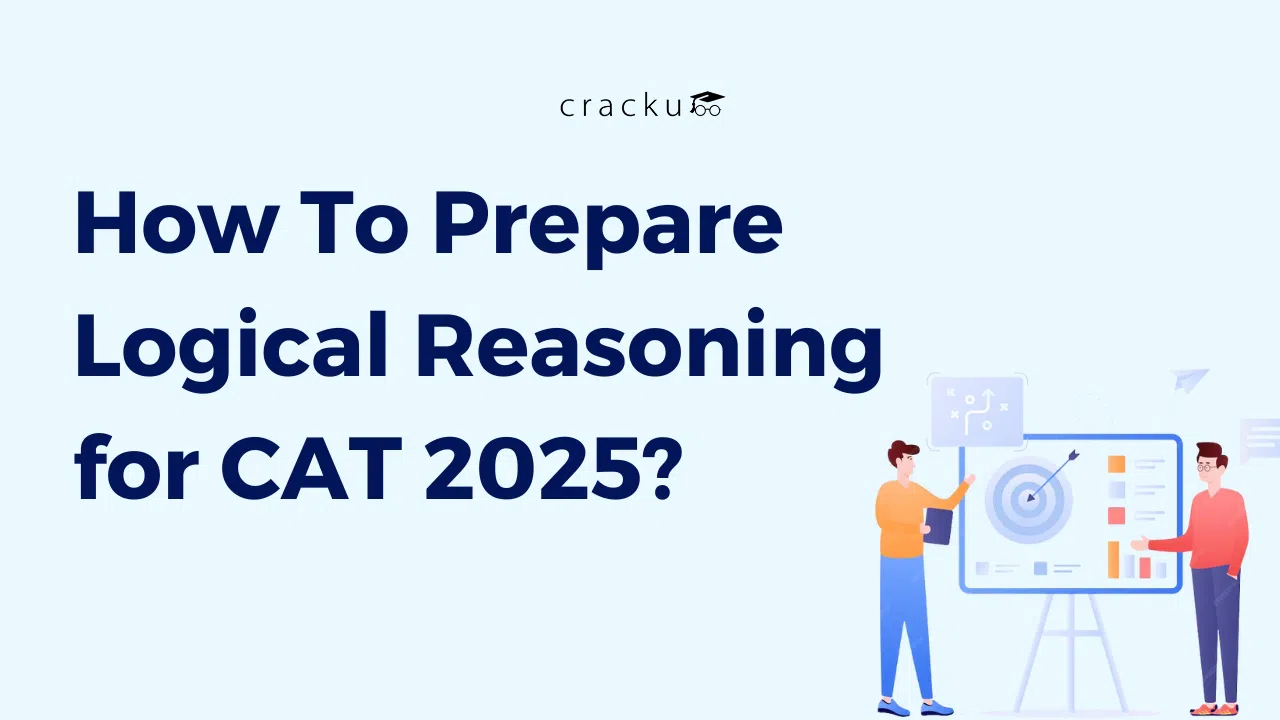How To Prepare Logical Reasoning For CAT 2025
For every MBA aspirant vying for excellent scores, cracking the Logical Reasoning (LR) Section of the CAT exam becomes an important task. With the right CAT preparation strategy, focused practice, and the best resources, you can transform it into one of your best scoring areas.
So, we will be exploring, in this blog, proven CAT Logical Reasoning Preparation Tips, strategy, important topics, approaches to practice questions, and the most recommended books for helping you master the LR section and boost your CAT 2025 performance.
CAT Logical Reasoning Topics
Below is a table summarizing the key CAT logical reasoning topics and their sub-topics:
| Section | Topic | Important Subtopics |
|---|---|---|
| Logical Reasoning (LR) | Arrangements | Linear Arrangements, Circular Arrangements, Complex Arrangements |
| Puzzles | Seating Arrangements, Floor-Based Puzzles, Scheduling | |
| Venn Diagrams | 2-set, 3-set, and 4-set Venn Diagram Problems | |
| Clocks & Calendars | Time and Date Calculations, Binary Logic | |
| Cubes & Visual Reasoning | Painted Cubes, Cutting & Folding, Dice Problems | |
| Logical Reasoning Misc | Logical Connectives, Team Selection, Truth/Lie, Routes & Networks, Coin Picking, Games & Tournaments, 2D/3D LR | |
| Data Interpretation (DI) | Tables | Profit-Loss Tables, Comparison Tables, Missing Data |
| Graphs | Line Graphs, Bar Graphs, Pie Charts | |
| Charts | Histograms, Area Charts, Scatter Plots | |
| Caselets | Analytical DI, Puzzle-Based DI, Miscellaneous Caselets | |
| Data Sufficiency | Logical Data Analysis, Sufficiency Conditions | |
| Advanced DI | DI with Connected Sets, Maxima-Minima, Selection with Conditions |
CAT Logical Reasoning Practice Questions:
- Practice Sets: At least solve 2 to 3 logical reasoning sets daily based on all topics mentioned above for a balanced preparation.
- CAT Previous Year Papers: Go through previous years' CAT logical reasoning questions to get a feel of question patterns and difficulty levels. Download PDFs of the CAT previous papers and try to solve every single set that came in the exam in the last 5 years.
- Online Resources: Use Cracku's Studyroom and CAT daily targets are the best when it comes to practicing quality questions with solutions and explanations.
Also Read, How To Prepare Verbal Ability for CAT 2025? Check Now
CAT Logical Reasoning Books
Choosing the right CAT logical reasoning books is crucial for effective preparation. Here’s a table of highly recommended books:
| Book Title | Author |
|---|---|
| CAT Logical Reasoning Book | Cracku |
| CAT Data Interpretation Book | Cracku |
| A Modern Approach to Logical Reasoning | R.S. Aggarwal |
| CAT Data Interpretation & Logical Reasoning | Gautam Puri |
| Data Interpretation & Data Sufficiency for CAT | Ananta Ashish |
Key Features to Prioritize:
- Structured Practice: Difficulty-wise CAT Logical reasoning topics are mentioned in the Cracku CAT book is of immense help for effective CAT preparation.
- Real-Exam Patterns: Nishit Sinha’s books is also one of the good resources when it comes to CAT Logical reasoning.
- Visual Aids: Look for books with flowcharts, grids, and Venn diagrams (e.g., Ananta Ashish).
CAT Logical Reasoning Strategy
- Begin With The Topics You Know: Start your preparation with the topics that you are already familiar with and gradually go onto the tougher ones.
- CAT Previous Paper: Download the CAT previous papers and start attempting the DILR sets without any timer. This way, you will get to know what kind of sets really come in CAT and you will be better able to understand the difficulty level of the logical reasoning sets in the CAT exam.
- Mix of Questions: Have a mixture of easy, moderate, and difficult sets so that you are prepared for any pattern in the exam.
- Mock Tests: Take frequent mock tests along with previous years’ CAT papers to know the difficulty level of the CAT exam and manage time well.
- Pattern Recognition: Concentrate on working out patterns and logical interconnections within the given data. This type of skill so developed is paramount for the efficient solving of puzzles and arrangements.
- Structured Approach: Take each question-type, take a systematic approach, and practice regularly to improve LR score.
Time Management Techniques for the CAT LRDI Section
Time management is key to maximizing your CAT score, and the LRDI section demands good time management skills. Here are some time-tested strategies to help you perform at your best:
1. Scan and Select the Right Sets
It is a known fact that during the first 2-3 minutes of the LRDI section, candidates should scan all the sets and make a mental note of sets that appear familiar, sets less data-intensive, or are more straightforward from a conceptual point of view. Try to do those sets that are comfortable for you and seem rather less ambiguous. Do not try to slog on sets-in case of complicated or unfamiliar ones-beginning with tough or rather unfamiliar ones but rather work out three to four sets with much accuracy.
2. Allocate Time Judiciously
The whole section for DILR has 40 minutes; logical reasoning sets should be allotted 15-20 minutes and the rest of the time for Data Interpretation. Ideally, in about 10-12 minutes, complete each set. Time-draining situations include taking longer for a set, wherein it is better to move on. Non-MCQ questions can be attempted first, as there is no negative marking.
3. Use a Structured Problem-Solving Approach
For organizing information quickly, use tables or grids or diagrams, especially for arrangements or puzzle types. Start with the most restrictive clues or data points; it will reduce the possibilities early in the set. Apply elimination methods to narrow down the options quickly.
4. Stay Flexible and Move On
Once stuck on a set for long hours, it becomes necessary to move on. Leaving a difficult set incomplete must be preferred to risking the missing of easy marks elsewhere. Upon the completion of easy sets, the candidate needs to revisit key unattempted or partially solved sets with his leftover time.
CAT Logical Reasoning Preparation Tips
- Scan the Entire Set: Before ever attempting the questions, have a quick scan of the whole logical reasoning set to get a general idea of the structure and parameters involved.
- Visualize and Structure: Draw grids, tables, or figures in order to organize information. Visual structure aids in breaking down complex problems.
- Identify Critical Data: Note down all given conditions and fill in direct data. Combine clues to interpret possibilities.
- Avoid Assumptions: Stick to the facts provided in the question. Do not bring in outside knowledge or assumptions.
- Time Management: If a set is too complex or time-consuming, move on and return to it later if time permits.
- Regular Practice: Solve a variety of logical reasoning practice questions to build familiarity and speed.
- Review Mistakes: Analyze errors in mock tests to avoid repeating them and to understand different question patterns.
How To Prepare Logical Reasoning For CAT 2025: Conclusion
Mastering CAT Logical Reasoning is a journey that combines consistent practice, smart strategy, and the right CAT study material. By focusing on structured preparation, analyzing your mock test performance, and continuously refining your approach, you can significantly improve your LRDI scores. Remember, success in CAT is not just about hard work but also about working smart and staying confident.
Ready to take your CAT Logical Reasoning preparation to the next level? Start practicing with Cracku’s expertly designed CAT LRDI practice sets, mock tests, and in-depth solutions, your one-stop platform for comprehensive MBA exam preparation.
Also Read, CAT Exam Details, Dates, Eligibility, Syllabus, Duration, Fees










![CAT Logical Reasoning Questions With Detailed Video Solutions [PDF] CAT Logical Reasoning Questions With Detailed Video Solutions [PDF]](/media/cache/33/ee/33ee6fb5fec03fe246df66f65a578e25.webp)








